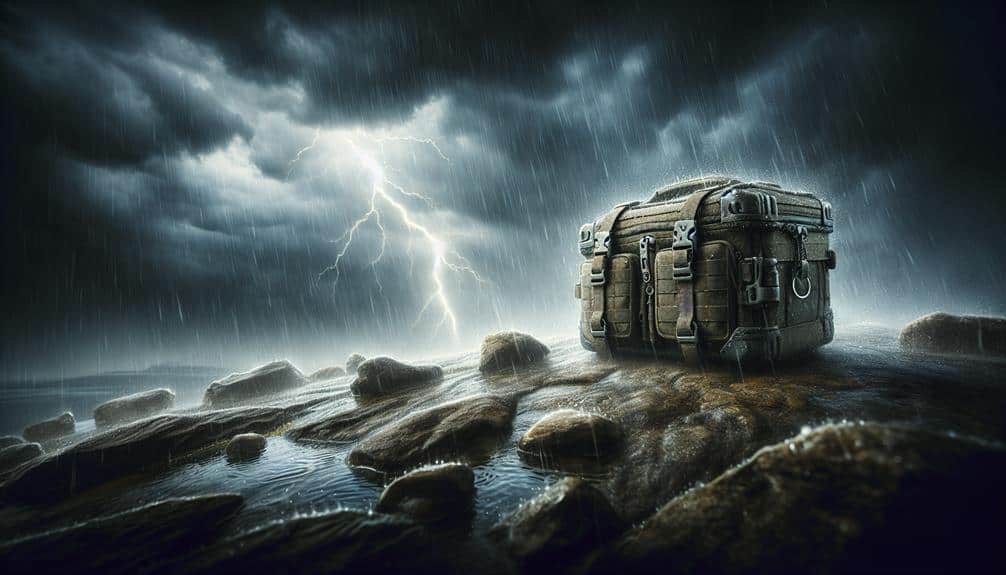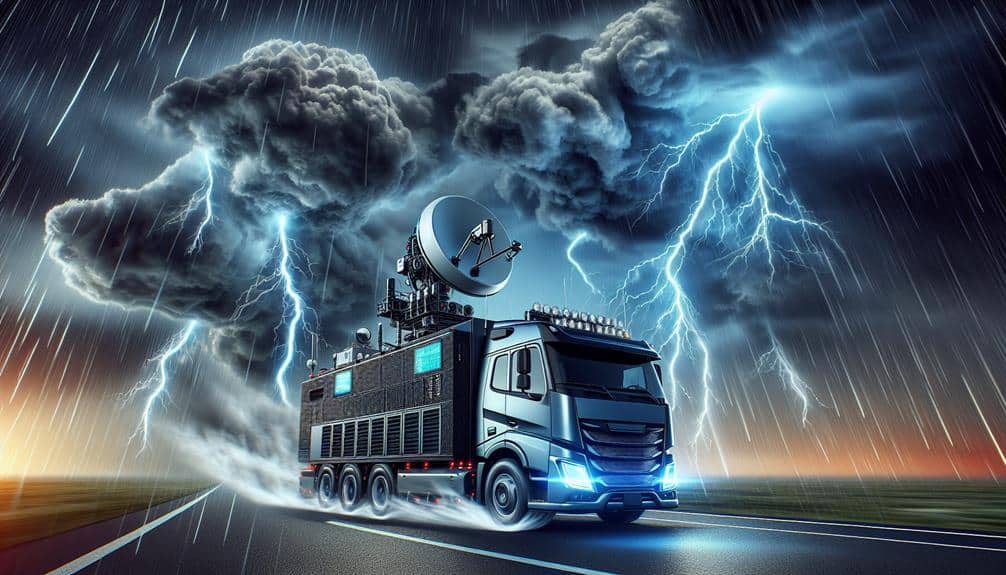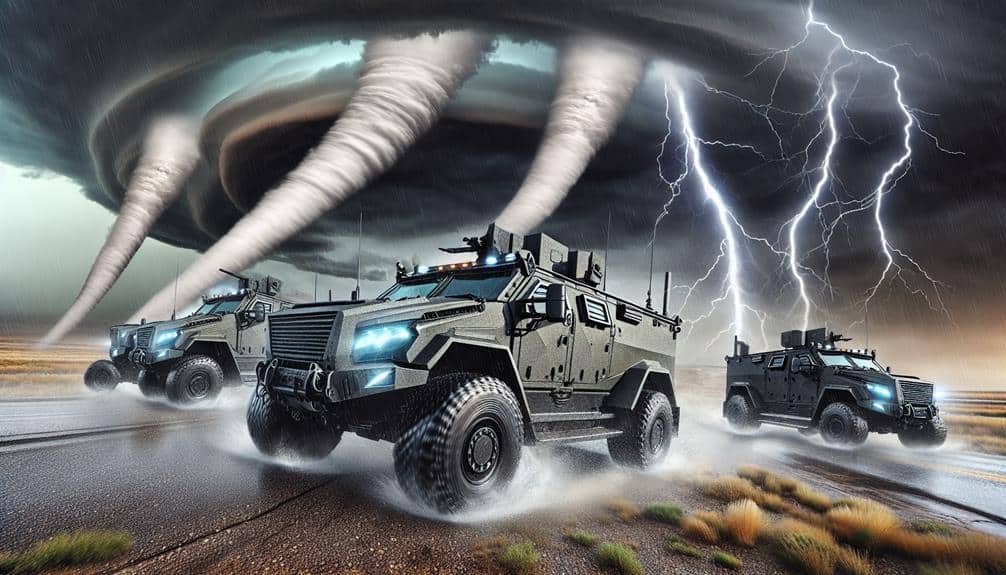We've meticulously reviewed the best storm chasing camera gear to guarantee you capture the raw power and dramatic beauty of severe weather. DSLR and mirrorless cameras, like the Canon EOS R5 and Sony A7R IV, offer exceptional low-light performance and durability. Pair these with weather-sealed wide-angle and telephoto lenses for diverse shots. Essential accessories include sturdy carbon fiber tripods, gimbals for smooth footage, and weatherproof camera bags to protect gear from harsh elements. Don't forget rain covers and remote shutter releases for added convenience. With this setup, you'll be well-prepared to capture every electrifying moment. Learn more about our detailed gear recommendations.
Key Points
- Weather-sealed DSLR and mirrorless cameras like the Sony A7R IV and Canon EOS R5 provide durability and superior image quality for storm chasing.
- Wide-angle and telephoto lenses with weather-sealing are essential for capturing the vastness and details of storm systems.
- High-quality tripods and stabilizers ensure stability and sharpness in extreme weather conditions.
- Weatherproof camera bags with waterproof zippers and padded compartments protect gear from harsh elements.
DSLR Cameras
When it comes to capturing the raw power of a storm, DSLR cameras provide the versatility and image quality necessary for professional-grade storm photography. We're talking about a tool that puts us in control of every frame, from tweaking camera settings to selecting the ideal shooting modes.
Let's start with the basics. In storm photography, we often face challenging light conditions. DSLRs shine in low light performance, allowing us to capture crisp, detailed images even when the sky is at its darkest. We can manually adjust the ISO to balance noise and sensitivity, and the shutter speed to freeze lightning or capture the motion of swirling clouds.
Shooting modes like Aperture Priority and Manual give us the freedom to fine-tune our exposure. Aperture Priority lets us control the depth of field, essential for isolating a dramatic element against a stormy backdrop. In Manual mode, we can dial in precise settings to match the unpredictable nature of storm light.
Moreover, DSLRs excel in image quality. With large sensors and high dynamic range, these cameras preserve the intricate details and vivid colors inherent in storm scenes. This makes our post-processing workflow smoother and more effective, ensuring each shot truly embodies the storm's essence.
Mirrorless Cameras
When it comes to storm chasing, mirrorless cameras offer some compelling advantages over DSLRs.
We'll explore our top mirrorless picks, focusing on models with fast autofocus, high frame rates, and weather-sealed bodies.
Understanding these essential features will help us capture those fleeting, intense moments with precision.
Top Mirrorless Camera Picks
Selecting the best mirrorless cameras is important for storm chasers who need excellent performance and reliability in extreme conditions. It's common knowledge that capturing the elusive beauty of a storm requires both versatility and precision. That's why we've narrowed down a few top picks that excel in lens options and image quality.
First up is the Sony A7R IV. Its 61-megapixel sensor offers unparalleled detail, essential for those once-in-a-lifetime storm shots. The wide range of E-mount lenses provides flexibility, from wide-angle landscapes to telephoto lightning strikes. Despite its powerful specs, it maintains a manageable size and weight, making it easy to carry during those long chases.
Next, we've got the Fujifilm X-T4. Known for its outstanding color science, this camera guarantees that the ominous hues of a brewing storm are captured accurately. It's compact and lightweight, perfect for quick maneuvers. Plus, Fujifilm's extensive lens lineup covers every shooting scenario you might encounter.
Lastly, the Canon EOS R5 is a strong contender with its 45-megapixel sensor and robust RF lens selection. It's slightly heavier than the others, but its superior image stabilization makes it worth the extra weight, ensuring sharp, clear images even in turbulent conditions.
Essential Features to Consider
While those top mirrorless camera picks offer superb performance, let's explore the key features that make them indispensable tools for storm chasers. First and foremost, camera durability and weather resistance are non-negotiable. Out in the field, facing torrential rain, high winds, and flying debris, our gear must withstand the harshest conditions. Many top-tier mirrorless cameras come with robust sealing and rugged bodies that shield against moisture, dust, and shocks. This guarantees we can keep shooting without worrying about equipment failure in critical moments.
Equally important is image quality and low light performance. Storms often bring unpredictable lighting, with sudden flashes of lightning contrasting against dark, ominous clouds. Our cameras need to excel in capturing these dramatic scenes with high dynamic range and sharpness. Superior low light performance ensures that even as daylight fades, our images retain clarity and detail, minimizing noise in the process.
Full-frame sensors and fast lenses are key here, allowing us to push the boundaries of what's achievable in challenging environments.
Lenses for Storm Chasing

When we're storm chasing, the right lenses make all the difference.
A wide-angle lens helps us capture the vastness of the storm, while a telephoto lens lets us zoom in on distant lightning or tornadoes.
It's essential that our lenses are weather-sealed to withstand harsh conditions and protect our gear.
Wide-Angle Lens Benefits
A wide-angle lens lets us capture the vastness and drama of storm systems, providing an expansive field of view that includes both the ground and the sky. When we're out in the field, we need to encapsulate the sheer scale of a storm, from the ominous clouds to the landscape beneath. The depth perception offered by wide-angle lenses adds a dynamic quality to our storm photography, making the viewer feel like they're right there with us, experiencing the raw power of nature.
In technical terms, these lenses excel at minimizing lens distortion, which is pivotal when documenting storms. We get to avoid the warping effect that can plague other types of lenses, ensuring that our images maintain their integrity. The wide-angle lens allows us to frame the entire scene, capturing the interplay between the storm clouds and the terrain. This is especially important for those dramatic moments when a storm cell looms large over the horizon.
Moreover, the ability to incorporate foreground elements enhances the storytelling aspect of our photos. We can juxtapose the enormity of the storm against smaller objects, providing context and scale, making our storm photography not just a visual experience, but an emotional one.
Telephoto Lens Advantages
Telephoto lenses frequently allow us to zero in on distant storm features with remarkable precision, capturing details that would be lost to the naked eye. When we're out chasing, these lenses let's frame the dramatic interplay of clouds, lightning, and atmospheric phenomena with unparalleled clarity. We can capture the swirling vortex of a tornado from a safe distance, ensuring our safety while still getting that heart-stopping shot.
For those of us who dabble in wildlife photography alongside storm chasing, a telephoto lens provides a dual-use advantage. We can photograph birds taking flight against a stormy backdrop or catch a deer silhouetted against a darkening sky. These lenses offer the versatility needed to switch between capturing a charging thunderhead and a fleeting wildlife moment without missing a beat.
Moreover, telephoto lenses excel at isolating elements in landscape shots, allowing us to highlight specific features like a lone tree against an ominous cloud bank or the intricate details of a lightning strike. They enable us to convey the raw power and beauty of nature in a way that wide-angle lenses simply can't match. With a telephoto lens, we command a unique perspective, capturing the essence of the storm.
Weather-Sealed Lens Importance
While telephoto lenses capture distant storm details with precision, ensuring our gear withstands harsh weather conditions is just as significant. That's why we prioritize weather-sealed lenses when storm chasing. These lenses provide critical lens protection against the elements, allowing us to focus on the shot rather than worrying about damaging our equipment.
When we're out in the field, we often face extreme conditions—torrential rain, gale-force winds, and flying debris. A weather-sealed lens is designed to resist moisture, dust, and dirt, maintaining peak performance even in the harshest environments. This robust construction not only safeguards the internal components but also guarantees the lens mount remains secure and functional.
We've learned that investing in quality weather-sealed lenses can be a game-changer. Brands like Canon, Nikon, and Sony offer a range of lenses specifically designed to withstand these extreme conditions. Features such as rubber gaskets and specialized coatings are essential for keeping our lenses operational and our shots pristine.
In our experience, the freedom to capture nature's fury without hesitation is invaluable. By choosing weather-sealed lenses, we protect our investment and ensure we're always ready to seize the perfect moment amidst the chaos of a storm.
Tripods and Stabilizers
Investing in high-quality tripods and stabilizers is vital for capturing sharp, stable footage during the intense conditions of storm chasing. Without tripod stability, even the most advanced cameras can't deliver clear shots amidst strong winds and unpredictable weather. When selecting a tripod, we prioritize sturdy, lightweight models. Carbon fiber tripods provide an excellent balance between durability and portability, ensuring that we can quickly move and set up without being burdened.
Stabilizers offer significant benefits by mitigating unwanted camera movement. Gimbals, for instance, are essential tools for achieving smooth, cinematic shots while on the move. They counteract the jerks and shakes that come with fast-paced storm chasing, allowing us to maintain focus on the unfolding weather phenomena.
Considering the equipment weight is vital. Lightweight gear reduces fatigue and lets us cover more ground efficiently. However, we don't compromise on stability. A robust tripod paired with an effective stabilizer guarantees that our footage remains rock-solid, even when the environment is anything but.
Weatherproof Camera Bags

Selecting weatherproof camera bags is vital for protecting our gear from the harsh elements encountered during storm chasing. When we're out in the field, we need bags that offer waterproof protection and durability. Our camera gear isn't just expensive; it's essential for capturing those perfect storm shots. That's why we need bags designed to withstand torrential rain, heavy winds, and even flying debris.
A good weatherproof camera bag provides more than just a barrier against water. It needs to guarantee comfort and functionality, especially when we're on the move. We don't want to be fumbling with zippers or struggling with straps when the perfect shot is waiting. Here's what to look for:
- Waterproof zippers and seams: Ensure no water seeps in.
- Durable materials: Opt for heavy-duty fabrics that can withstand rough conditions.
- Padded compartments: Keep our gear safe from shocks and drops.
In our storm-chasing adventures, the right bag can make all the difference. We need something reliable that lets us focus on capturing the storm, not worrying about our gear's safety.
Essential Camera Accessories
To capture the most dramatic storm images, we rely on necessary camera accessories that enhance our shooting capabilities and ensure our equipment's reliability.
First and foremost, camera protection is crucial. We use rain covers and weatherproof camera bags to shield our gear from harsh elements. These covers fit snugly around our cameras and allow us to adjust settings without exposing the equipment to rain or dust.
Tripods are another essential accessory. A sturdy, weather-resistant tripod guarantees stability during long exposure shots, a key photography technique for capturing lightning and other transient storm phenomena. We often rely on tripods with spiked feet for better grip on wet, uneven terrain.
Remote shutter releases allow us to take sharp images without touching the camera, reducing the risk of motion blur. Wireless options give us the freedom to shoot from a distance, enhancing our safety during severe weather.
Lastly, lens filters are crucial. UV filters provide an added layer of protection for our lenses, while polarizing filters help manage reflections and enhance contrast, making storm clouds look even more dramatic.
Frequently Asked Questions
How Can I Ensure My Safety While Storm Chasing?
Did you know 70% of storm chasers have faced life-threatening situations? To guarantee our safety, we must follow strict safety precautions, have detailed emergency plans, and stay updated on weather forecasts to make informed decisions.
What Are the Best Apps for Tracking Storms?
For storm tracking apps, we prioritize accuracy and reliability. Our top picks feature intuitive user interfaces and real-time updates. RadarScope, Storm Shield, and MyRadar excel in these areas, providing excellent tools for precise storm tracking.
How Do I Capture Lightning in My Photos?
To capture lightning, we use long exposure and manual settings. Essential capturing techniques include a tripod for stability and low ISO. For editing tips, adjust contrast and highlights. Composition tricks involve framing the storm for dramatic effect.
What Is the Best Time of Year for Storm Chasing?
We understand weather patterns can be unpredictable, but spring offers ideal storm chasing locations. Let's prioritize safety precautions while capturing epic shots. Mastering photography techniques during this season guarantees we achieve stunning results without compromising our safety.
Are There Any Storm Chasing Tours for Beginners?
Yes, there are storm chasing tours for beginners. They provide essential storm chasing equipment and guide us to prime storm chasing locations. These tours guarantee we get an adrenaline rush while staying safe and informed.

